Showing Spotlights 2017 - 2024 of 2785 in category All (newest first):
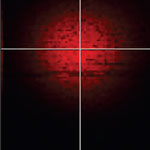 In a recent Nanowerk Spotlight we reported on a single molecule approach to directly visualize and map protein binding sites on DNA using fluorescent quantum dots. One of the challenges the researchers in this work had was to measure distances between probes bound to combed DNA with nanometer resolution. Whereas very short distance (below 10 nm) can be assessed by FRET measurements and distances above the Rayleigh criterion can be measured, say, with a standard microscopy picture and a ruler, distances in between need to be addressed differently. This is were a novel approach by scientists at UCLA fills the gap, and, as they claim, better than other techniques do.
In a recent Nanowerk Spotlight we reported on a single molecule approach to directly visualize and map protein binding sites on DNA using fluorescent quantum dots. One of the challenges the researchers in this work had was to measure distances between probes bound to combed DNA with nanometer resolution. Whereas very short distance (below 10 nm) can be assessed by FRET measurements and distances above the Rayleigh criterion can be measured, say, with a standard microscopy picture and a ruler, distances in between need to be addressed differently. This is were a novel approach by scientists at UCLA fills the gap, and, as they claim, better than other techniques do.
May 27th, 2009
 A major concern in microbiology is to determine whether a bacterium is dead or alive. This crucial question has major consequences in food industry, water supply or health care. While culture-based tests can determine whether bacteria can proliferate and form colonies, these tests are time-consuming and work poorly with certain slow-growing or non-culturable bacteria. They are not suitable for applications where real-time results are needed, e.g. in industrial manufacturing or food processing. A team of scientists in France has now discovered that living and dead cells can be discriminated with a nanotechnology technique on the basis of their cell wall nanomechanical properties.
A major concern in microbiology is to determine whether a bacterium is dead or alive. This crucial question has major consequences in food industry, water supply or health care. While culture-based tests can determine whether bacteria can proliferate and form colonies, these tests are time-consuming and work poorly with certain slow-growing or non-culturable bacteria. They are not suitable for applications where real-time results are needed, e.g. in industrial manufacturing or food processing. A team of scientists in France has now discovered that living and dead cells can be discriminated with a nanotechnology technique on the basis of their cell wall nanomechanical properties.
May 26th, 2009
 A recent report gives an overview of how five jurisdictions (US, UK, EU, Australia and Canada) reacted to the recent emergence of nanotechnology-based products in the marketplace and it describes how this triggered activities in three domains: (a) public and stakeholder debate, (b) development of initial policy options, and (c) the management of regulatory development in a situation of scarce data. The bulk of the report describes the current situation (up to March 2009) in the five jurisdictions and this part doesn't contain information that hasn't already been covered elsewhere. In analyzing this data, however, the authors make some interesting observations and attempt to develop a set of six key regulatory governance principles that they propose for consideration by regulators.
A recent report gives an overview of how five jurisdictions (US, UK, EU, Australia and Canada) reacted to the recent emergence of nanotechnology-based products in the marketplace and it describes how this triggered activities in three domains: (a) public and stakeholder debate, (b) development of initial policy options, and (c) the management of regulatory development in a situation of scarce data. The bulk of the report describes the current situation (up to March 2009) in the five jurisdictions and this part doesn't contain information that hasn't already been covered elsewhere. In analyzing this data, however, the authors make some interesting observations and attempt to develop a set of six key regulatory governance principles that they propose for consideration by regulators.
May 25th, 2009
 In a previous Nanowerk Spotlight we have reported about the work of Chinese scientists who demonstrated that a sheet of carbon nanotube (CNT) thin film could be a practical magnet-free loudspeaker simply by applying an audio frequency current through it . The team has now reported that their CNT films can also work as an incandescent display, driven by a simple addressing circuit with response times faster than that of liquid crystal displays (LCDs). At the same time, the incandescent light of the CNT film is almost nonpolarized, and will not have the viewing-angle problem of LCDs. The CNT films in vacuum can be heated to incandescence and cooled down in about 1 millisecond by turning on and shutting off the heating voltage.
In a previous Nanowerk Spotlight we have reported about the work of Chinese scientists who demonstrated that a sheet of carbon nanotube (CNT) thin film could be a practical magnet-free loudspeaker simply by applying an audio frequency current through it . The team has now reported that their CNT films can also work as an incandescent display, driven by a simple addressing circuit with response times faster than that of liquid crystal displays (LCDs). At the same time, the incandescent light of the CNT film is almost nonpolarized, and will not have the viewing-angle problem of LCDs. The CNT films in vacuum can be heated to incandescence and cooled down in about 1 millisecond by turning on and shutting off the heating voltage.
May 22nd, 2009
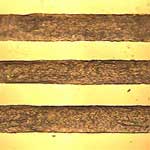 The prospect of stretchable electronics opens some exciting possibilities - for instance, think about artificial skin with an integrated, stretchable touchscreen display. To get there, researchers have begun developing elastic electrical wiring that is both highly conductive and highly stretchable. Currently existing stretchable materials do already exhibit excellent conductivity and mechanical stretchability but they have one major disadvantage: their manufacturing processes are not readily scalable, which means it is difficult or cost-prohibitive to apply them to large-area electronics. A research team in Japan has now successfully fabricated, for the first time, novel elastic conductors that can be directly patterned by printing processes. This novel, printable elastic conductor comprises single-walled carbon nanotubes uniformly dispersed in a highly elastic fluorinated copolymer rubber.
The prospect of stretchable electronics opens some exciting possibilities - for instance, think about artificial skin with an integrated, stretchable touchscreen display. To get there, researchers have begun developing elastic electrical wiring that is both highly conductive and highly stretchable. Currently existing stretchable materials do already exhibit excellent conductivity and mechanical stretchability but they have one major disadvantage: their manufacturing processes are not readily scalable, which means it is difficult or cost-prohibitive to apply them to large-area electronics. A research team in Japan has now successfully fabricated, for the first time, novel elastic conductors that can be directly patterned by printing processes. This novel, printable elastic conductor comprises single-walled carbon nanotubes uniformly dispersed in a highly elastic fluorinated copolymer rubber.
May 20th, 2009
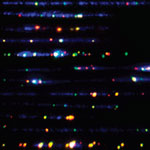 Proteins that bind to specific sites of DNA are essential to all biological functions of DNA. These DNA-binding proteins include transcription factors which modulate the process of transcription, various polymerases, nucleases which cleave DNA molecules, and histones which are involved in chromosome packaging in the cell nucleus. Developing methods to precisely determine the locations and occupancy of DNA-binding proteins is instrumental to scientists' understanding of cellular processes like gene expression and regulation. Motivated by the desire to overcome some of the inherent limitations of existing biochemical techniques for mapping protein binding sites on DNA, scientists at UCLA have now demonstrated the viability of a single molecule approach to directly visualize and map protein binding sites on DNA using fluorescent quantum dots, allowing multicolor, nanometer-resolution localization.
Proteins that bind to specific sites of DNA are essential to all biological functions of DNA. These DNA-binding proteins include transcription factors which modulate the process of transcription, various polymerases, nucleases which cleave DNA molecules, and histones which are involved in chromosome packaging in the cell nucleus. Developing methods to precisely determine the locations and occupancy of DNA-binding proteins is instrumental to scientists' understanding of cellular processes like gene expression and regulation. Motivated by the desire to overcome some of the inherent limitations of existing biochemical techniques for mapping protein binding sites on DNA, scientists at UCLA have now demonstrated the viability of a single molecule approach to directly visualize and map protein binding sites on DNA using fluorescent quantum dots, allowing multicolor, nanometer-resolution localization.
May 19th, 2009
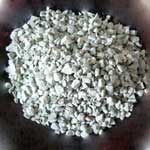 Zeolites are microporous, aluminosilicate minerals commonly used as commercial adsorbents. These materials are also known as molecular sieve - they contain tiny pores of a precise and uniform size that are useful as adsorbent for gases and liquids. Due to these characteristics, zeolite has found wide applications in adsorption, catalysis, and the removal of heavy metal ions from industrial wastewaters. The zeolites commonly used to remove heavy metal ions from industrial effluent are in the form of fine powders and must be recovered by solid-liquid separation subsequent to the purification process. Although the separation is possible for single-phase liquid or gas detoxification processes, the practical application of fine zeolite powders to complex multiphase systems is rather limited. Researchers in Canda have now devised a new technology to separate the spent sorbent powders from treated streams. This could extend the application of zeolites to a much wider range of systems.
Zeolites are microporous, aluminosilicate minerals commonly used as commercial adsorbents. These materials are also known as molecular sieve - they contain tiny pores of a precise and uniform size that are useful as adsorbent for gases and liquids. Due to these characteristics, zeolite has found wide applications in adsorption, catalysis, and the removal of heavy metal ions from industrial wastewaters. The zeolites commonly used to remove heavy metal ions from industrial effluent are in the form of fine powders and must be recovered by solid-liquid separation subsequent to the purification process. Although the separation is possible for single-phase liquid or gas detoxification processes, the practical application of fine zeolite powders to complex multiphase systems is rather limited. Researchers in Canda have now devised a new technology to separate the spent sorbent powders from treated streams. This could extend the application of zeolites to a much wider range of systems.
May 18th, 2009
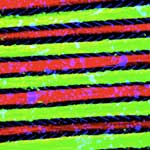 One of the key issues in building implantable neural interfaces is the guidance of axons, the individual nerve fibers that act as the primary transmission lines of the nervous system. The ability to control the connections between neurons by guiding their axons on a chip surface offers several advantages. Among them is the possibility to address axons from different types of neurons, e.g., motor neurons from sensory neurons. This is a prerequisite condition for bidirectional neural implants such as brain machine interfaces. Axonal guidance has been achieved before, and there are various chemical and topographical modification techniques to do so. However, scientists only managed to control the orientation of the nerve fibers. In new work, a Swedish team shows that it is possible to impose a growth direction at a specific location on a substrate, something which is very important for neural chip construction for example. The first application for this research would be in neural network design.
One of the key issues in building implantable neural interfaces is the guidance of axons, the individual nerve fibers that act as the primary transmission lines of the nervous system. The ability to control the connections between neurons by guiding their axons on a chip surface offers several advantages. Among them is the possibility to address axons from different types of neurons, e.g., motor neurons from sensory neurons. This is a prerequisite condition for bidirectional neural implants such as brain machine interfaces. Axonal guidance has been achieved before, and there are various chemical and topographical modification techniques to do so. However, scientists only managed to control the orientation of the nerve fibers. In new work, a Swedish team shows that it is possible to impose a growth direction at a specific location on a substrate, something which is very important for neural chip construction for example. The first application for this research would be in neural network design.
May 13th, 2009
 In a recent Nanowerk Spotlight we reported on a single molecule approach to directly visualize and map protein binding sites on DNA using fluorescent quantum dots. One of the challenges the researchers in this work had was to measure distances between probes bound to combed DNA with nanometer resolution. Whereas very short distance (below 10 nm) can be assessed by FRET measurements and distances above the Rayleigh criterion can be measured, say, with a standard microscopy picture and a ruler, distances in between need to be addressed differently. This is were a novel approach by scientists at UCLA fills the gap, and, as they claim, better than other techniques do.
In a recent Nanowerk Spotlight we reported on a single molecule approach to directly visualize and map protein binding sites on DNA using fluorescent quantum dots. One of the challenges the researchers in this work had was to measure distances between probes bound to combed DNA with nanometer resolution. Whereas very short distance (below 10 nm) can be assessed by FRET measurements and distances above the Rayleigh criterion can be measured, say, with a standard microscopy picture and a ruler, distances in between need to be addressed differently. This is were a novel approach by scientists at UCLA fills the gap, and, as they claim, better than other techniques do.
 Subscribe to our Nanotechnology Spotlight feed
Subscribe to our Nanotechnology Spotlight feed





